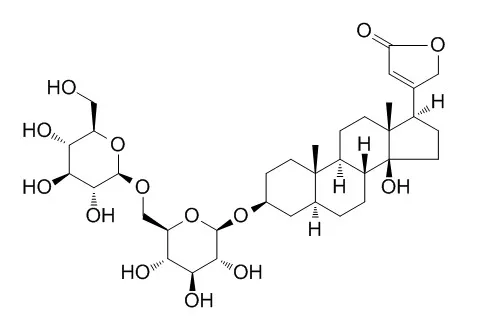| In vivo: |
| International Journal of Clinical Pharmacology & Therapeutics, 2012, 50(10):729-740. | | Cardiovascular effects, pharmacokinetics and cross-reactivity in digitalis glycoside immunoassays of an antidiarrheal uzara root extract.[Reference: WebLink] | Uzara glycosides (UG) extracted from Xysmalobium undulatum are used for treating non-specific diarrhea.Cross-reactivity has been described for UG in digitalis glycoside assays but digitalis-like cardiac effects are controversially discussed.
METHODS AND RESULTS:
Therefore, we performed a randomized, singleblind cross-over study in 18 healthy volunteers receiving a commercially available Uzara product (Uzara® Lösung N, Stada AG, Bad Vilbel, Germany (ULN)), digoxin (1 mg, i.v., positive control) and placebo in double-dummy technique. Pharmacodynamic effects were quantified by means of ECG and impedance cardiography (ICG). After oral administration of ULN, main metabolites were determined using HPLC-MS/MS and digitalis-like serum levels (DLSL) were measured in two digitoxin and digoxin assays, respectively. In comparison to placebo, ULN did not change significantly any PD parameters whereas digoxin altered significantly area under the effect curve of several ECG and ICG parameters, respectively. Since some serum levels of three ULN ingredients (Uzarin, uzarigenin and xysmalorin) were below LLQ, PK analyses could only be performed for allouzarigenin and revealed a marked inter-individual variability. Therefore, median values (min; max) were calculated as follows: Cmax = 0.39 (0.15; 1.81) ng/ml, tmax = 7.0 (3.0; 36.0) h, T1/2 = 5.2 (0.8; 23.6) h, AUC0-36h = 4.2 (0.8; 11.1) ng/ml×h, AUC0-∞ = 5.8 (1.8; 13.1) ng/ml×h. DLSL reached Cmax of 28 ng/ml and 1,980 ng/ml for digoxin and digitoxin, respectively.
CONCLUSIONS:
We could not observe significant cardiovascular pharmacodynamic effects after oral administration of the recommended single dose of Uzara extract to healthy volunteers. However, considerable DLSL could be detected, proving cross-reactivity of uzara components with the conventional digitalis assays used. However, none of the metabolites we had suspected to be the cause for the crossreactivity could be identified in reasonable quantities. |
|






 Cell. 2018 Jan 11;172(1-2):249-261.e12. doi: 10.1016/j.cell.2017.12.019.IF=36.216(2019)
Cell. 2018 Jan 11;172(1-2):249-261.e12. doi: 10.1016/j.cell.2017.12.019.IF=36.216(2019) Cell Metab. 2020 Mar 3;31(3):534-548.e5. doi: 10.1016/j.cmet.2020.01.002.IF=22.415(2019)
Cell Metab. 2020 Mar 3;31(3):534-548.e5. doi: 10.1016/j.cmet.2020.01.002.IF=22.415(2019) Mol Cell. 2017 Nov 16;68(4):673-685.e6. doi: 10.1016/j.molcel.2017.10.022.IF=14.548(2019)
Mol Cell. 2017 Nov 16;68(4):673-685.e6. doi: 10.1016/j.molcel.2017.10.022.IF=14.548(2019)